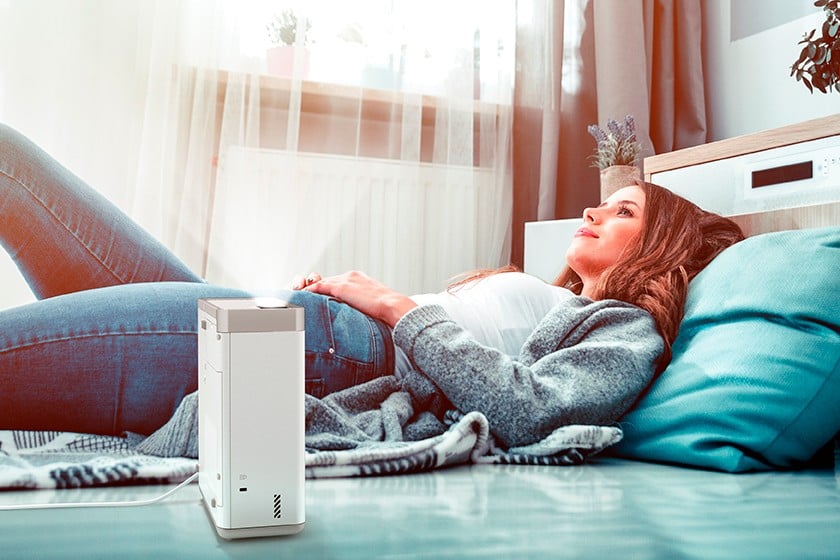
The Epson EF-100—available in either black or white and rated at 2,000 lumens—is impressively different from most home projectors, but not in the way Epson suggests. The company refers to it in full as a “Mini-Laser Streaming Projector With Android TV,” and focuses on the streaming part. But you can plug a streaming dongle into any projector. The bigger difference is the “mini-laser” bit, with equal emphasis on “mini” and “laser.” It’s also what makes the EF-100 worth its high price—officially $999.99 on Epson’s website, reduced to $699.99 from some sellers at this writing—despite its modest 1,280-by-800-pixel native resolution and lack of optical zoom or support for 3D, HDR, or input resolutions above 1080p. What the EF-100 offers instead: all the advantages of a laser light source in what is, at anywhere near its brightness, the least expensive, smallest, and lightest home laser projector to date.
The only key advantage lasers don’t have over traditional lamps as a projection source is price. To begin with, they’re meant to last the life of the projector, so you don’t have to shell out money for replacements or go through the bother of replacing a lamp. And, unlike lamps, they lose brightness gradually throughout their lives, rather than dropping by a lot early on and then decaying gradually after that.
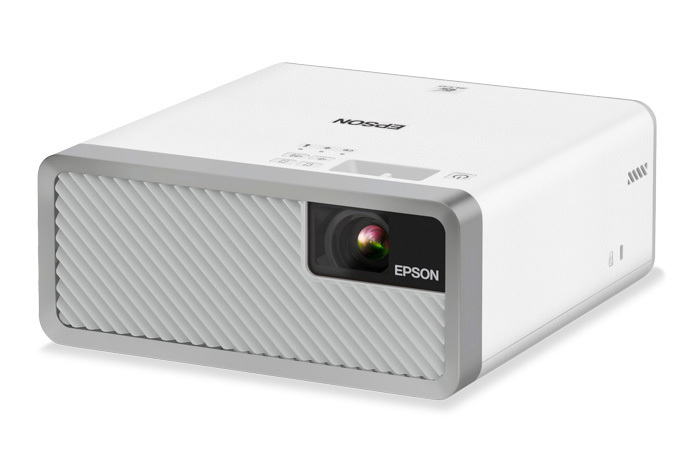
Epson rates the EF-100’s light source at 12,000 hours at full power—long enough to run for five hours a day, every day, for more than six years. At lowest power mode, the life jumps to 20,000 hours. As a point of reference, the lamp life for the 720p Epson Home Cinema 760 is just half as long in both full-power and eco modes. Another advantage, as with most laser projectors, is that the EF-100 has a range of power settings, adding nine intermediate steps between full-power and eco modes. Adjusting the power to give you just the brightness you need can both extend the life of the laser and save on electricity.
Lasers also make it easier to design projectors to work in almost any orientation. For a home projector like the EF-100, that translates to possibilities like pointing straight up to watch movies or TV on the ceiling.

The longer life for a laser can also help make up for a higher initial cost. A case in point: Using Epson’s official full prices, the Home Cinema 760 is about $450 less than the EF-100 at this writing, but to make them more comparable in features, you’d have to add an HDMI streaming device to the 760, which brings the difference to about $390. If you also have to buy just one lamp over the projector’s lifetime, the difference drops to $330, not counting the abovementioned $300 discount.
As a result, by the time you’re ready for a new model, the total cost for a laser projector may not be much more than for a lamp-based alternative. And in this case, you still wouldn’t have all of the EF-100’s features, including a better-quality speaker, an audio-out port, and Bluetooth speaker support.
What turns the EF-100 into an Android TV is the Epson-branded HDMI Android TV dongle it comes with. To set it up, you snap off the projector’s back panel, plug the dongle into the sole HDMI port, and connect the supplied USB cable between the dongle and the projector’s USB Type-A port for power. The HDMI port sits at the end of a captured cable, so the dongle can rest in a recessed area designed to hold it.
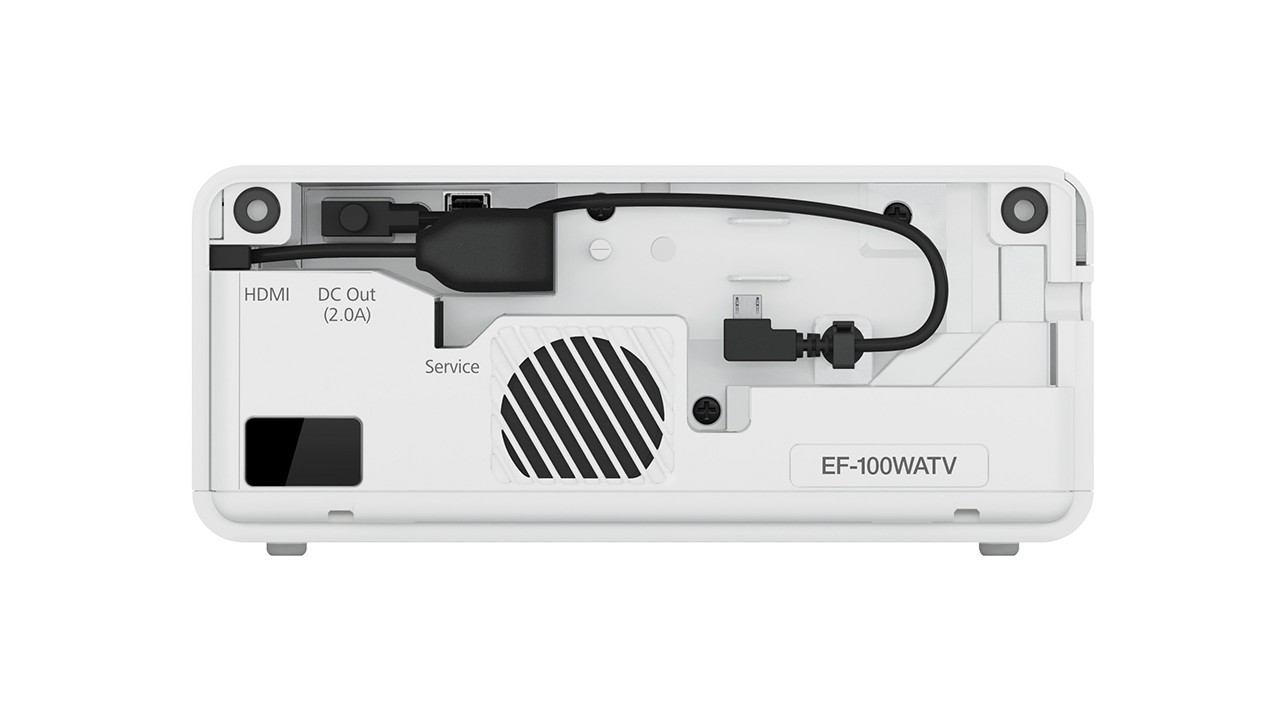
Replacing the back cover hides the cables and dongle, leaving an uncluttered back of the projector that will fit nicely in any decor. The dongle also supplies the Wi-Fi connection to your network, so it can connect to Chromecast-enabled apps on computers and mobile devices, and to the Internet to stream from Netflix, Hulu, HBO, and elsewhere, all of which turns the EF-100 into, in essence, a cord-cutting TV.
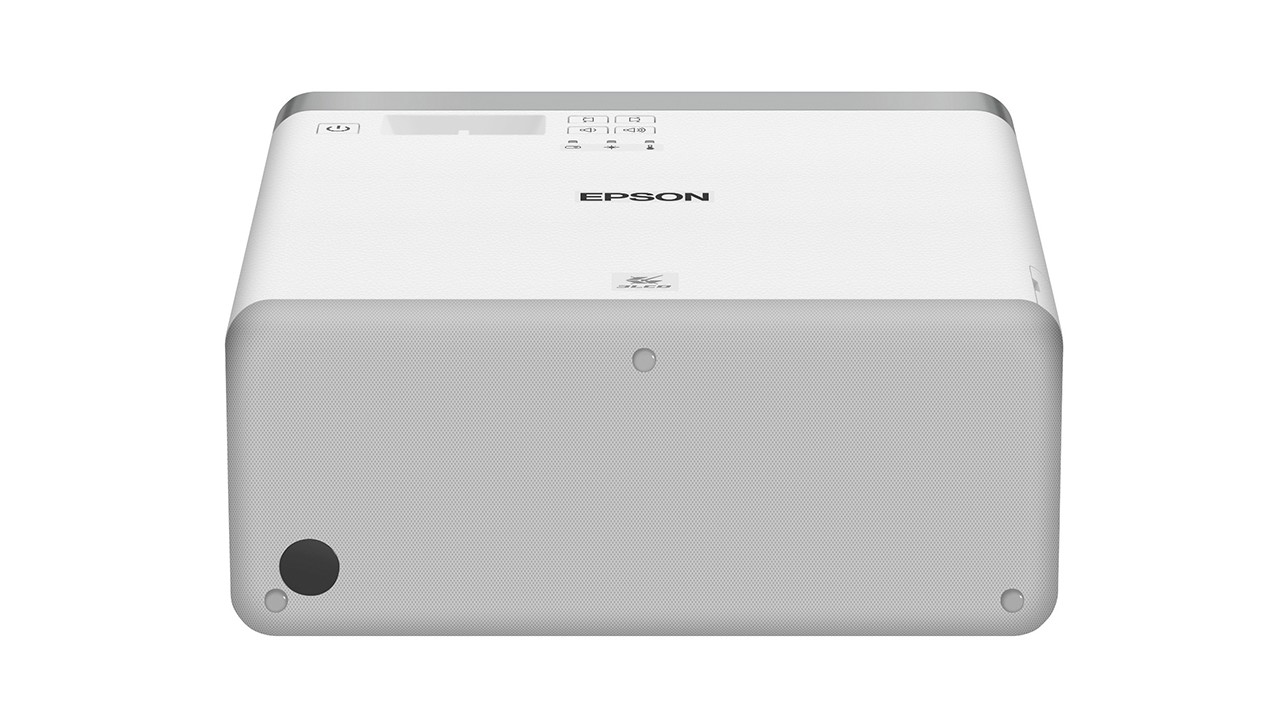
If you prefer, you can ignore the supplied dongle and use another one instead, or you can connect to any video source or PC using an HDMI cable. The back panel even includes a track and a small opening for a cable on one side. However, with only one HDMI port, you can’t connect both a dongle and another video source, like a Blu-ray player, at the same time. Aside from a service port for upgrading firmware, the only other connectors are the power connector on the right side, near the back, and a 3.5mm audio port just above it.
Most laser projectors are notably bigger and heavier than comparable lamp-based projectors. The EF-100 isn’t, which is why the “mini” part of the mini-laser description matters. Barely larger than a school lunchbox, at 3.6 by 8.3 by 9.1 inches (HWD) including feet, it weighs just 6 pounds, making it easy to carry from room to room and small enough to leave sitting on a coffee table or store unobtrusively on a bookshelf when you’re not using it.
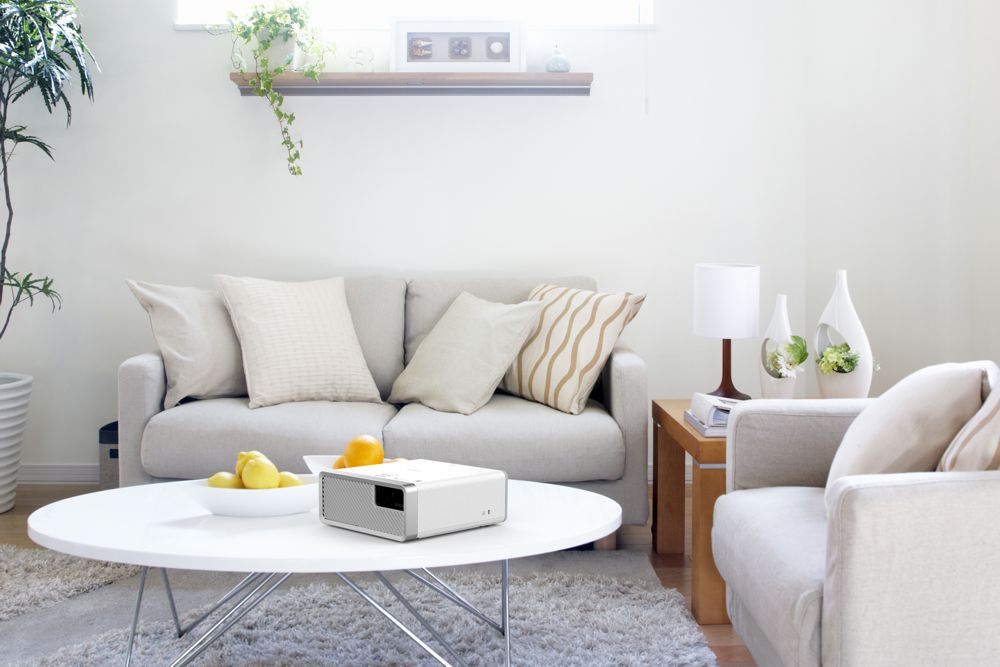
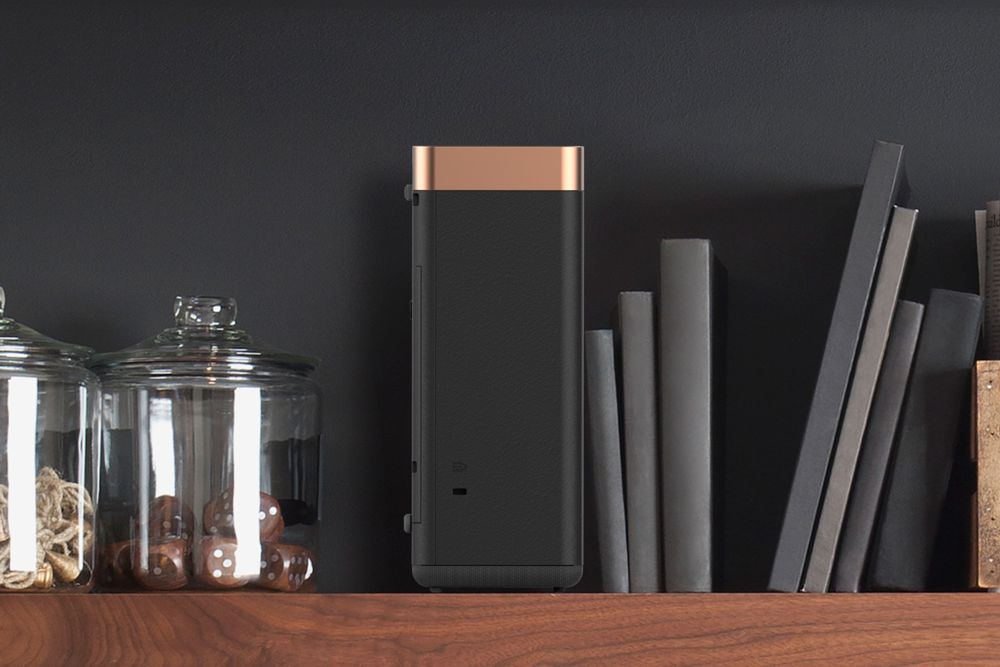
To set the projector up, you simply connect an HDMI cable or let it connect to your Wi-Fi network. After that, you would move the projector to adjust image size and position, and use the manual horizontal and the auto or manual vertical keystone adjustments to square off the image. Focus is done manually. There’s also a digital zoom for adjusting image size, but it’s best avoided, since anything smaller than the full size will lower brightness and can introduce artifacts.
A minor complication for the EF-100’s brightness is that its rating of 2,000 lumens applies to the native 16:10 aspect ratio. However, most streaming sites, Blu-ray discs, and TV shows today use a 16:9 aspect ratio, which means 10 percent of the pixels are set to black, blocking 10 percent of the light. The good news is that even 1,800 lumens translates to a usefully high brightness, especially since the 3LCD design (meaning it uses three LCD chips) means color images are fully as bright as you would expect from the white brightness, which isn’t always true of single-chip designs.
Based on Society of Motion Picture and Television Engineers (SMPTE) recommendations, 1,800 lumens is bright enough in a dark room for a 190-inch diagonal 16:9 image, assuming a 1.0-gain screen. For moderately bright ambient light, the size drops to 110 inches. In my formal tests in a dark room, even the lowest-brightness picture mode produced a suitably bright image on a 90-inch screen. In more informal tests using an 80-inch screen in a family room, the low-brightness Cinema mode delivered a bright image with lights on at night, while the brightest predefined mode (Dynamic) stood up to daylight streaming through the windows.
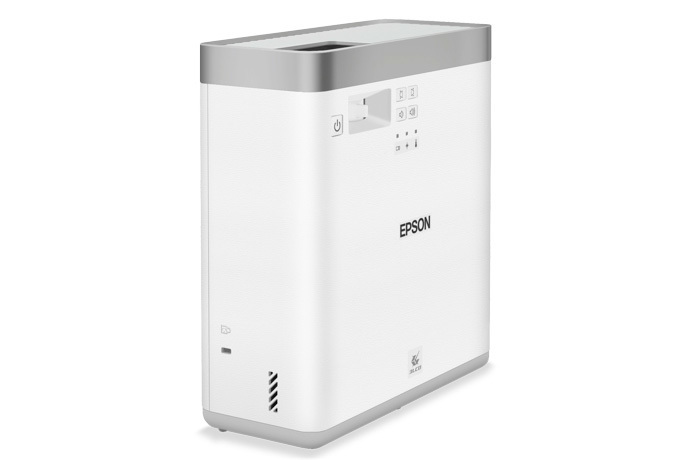
Image quality is easily good enough for the kind of casual viewing the EF-100 is meant for. Sharpness and level of detail was appropriate for the projector’s resolution, and most people will consider the color accuracy more than acceptable even in the brightest mode—something best avoided with most projectors.
Contrast gets slightly lower marks. The color mode with the best contrast, Cinema, showed most but not all of the shadow detail in the darkest scenes in our test suite, and it lacked the sense of three-dimensionality that comes from dark blacks and top-tier contrast. However, it held up well in ambient light, which tends to wash out contrast regardless of how good it looks in a dark room. Another plus is that the 3LCD design means that it can’t show rainbow artifacts—the red-green-blue flashes that single-chip projectors can show.
Under the category of useful conveniences, the remote includes two buttons specifically for streaming—one to call up YouTube, and one to launch the Apps screen.
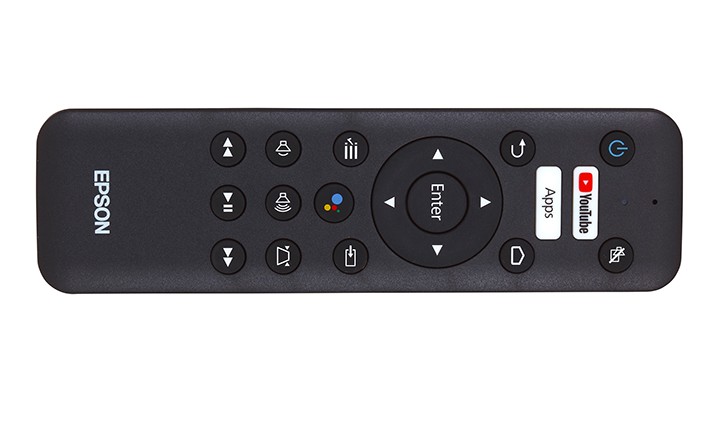
Also important is that the EF-100’s built-in 5-watt speaker delivers easily enough volume to fill a family room, along with good enough sound quality to be useful. For higher volume or better quality, you can connect to an external sound system or speakers using Bluetooth or the 3.5mm audio-out port. Note, too, that I measured the EF-100’s lag time at 39 milliseconds, which is easily good enough for casual gaming.
Whether you want a projector that’s designed as part of an Android TV bundle, or don’t much care about the included dongle, the Epson EF-100 is well worth considering. But keep in mind that you can add a streaming dongle to any projector with an HDMI port.
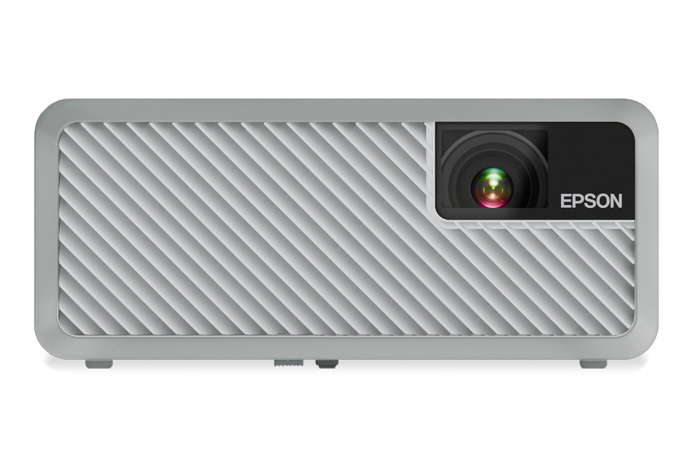
you’d rather keep initial costs down and you don’t need higher resolution than 720p, you will probably prefer a lamp-based model like the Epson Home Cinema 760. Alternatively, if you want higher resolution while still staying at an under-$1,000 price, take a look at lamp-based 1080p models like the BenQ HT2150ST, the Optoma HD39HDR, or the ViewSonic PX701HD. But if you want the advantages of a laser light source, the Epson EF-100 offers a unique combination at this writing: a low price for a laser projector, a compact size, excellent room-to-room portability, and a level of image quality and brightness that will stand up well in ambient light.
Epson EF-100 Mini-Laser Streaming Projector With Android TV Specs
Engine Type LCD
Rated Brightness 2000 ANSI lumens
Native Resolution 1280 by 800
Maximum Resolution 1280 by 800
Inputs and Interfaces HDMI, USB
Dimensions (HWD) 3.6 by 8.3 by 9.1 inches
Weight 6 lbs
Warranty 2 years

Free ground shipping on orders all $99 and up.

We are an authorized dealer for every brand we sell.

Special pricing for preffered customers and dealers.

We are projector experts, with over 20 years of service.

From projectors to projection screens, digital signage to gaming equipment, PSSAV is Your number one source for audio visual equipment. over 200 top brands including Sony, Nec, Epson, Optoma, Benq, Chief, Dalite, Viewsonic, LG and more..
